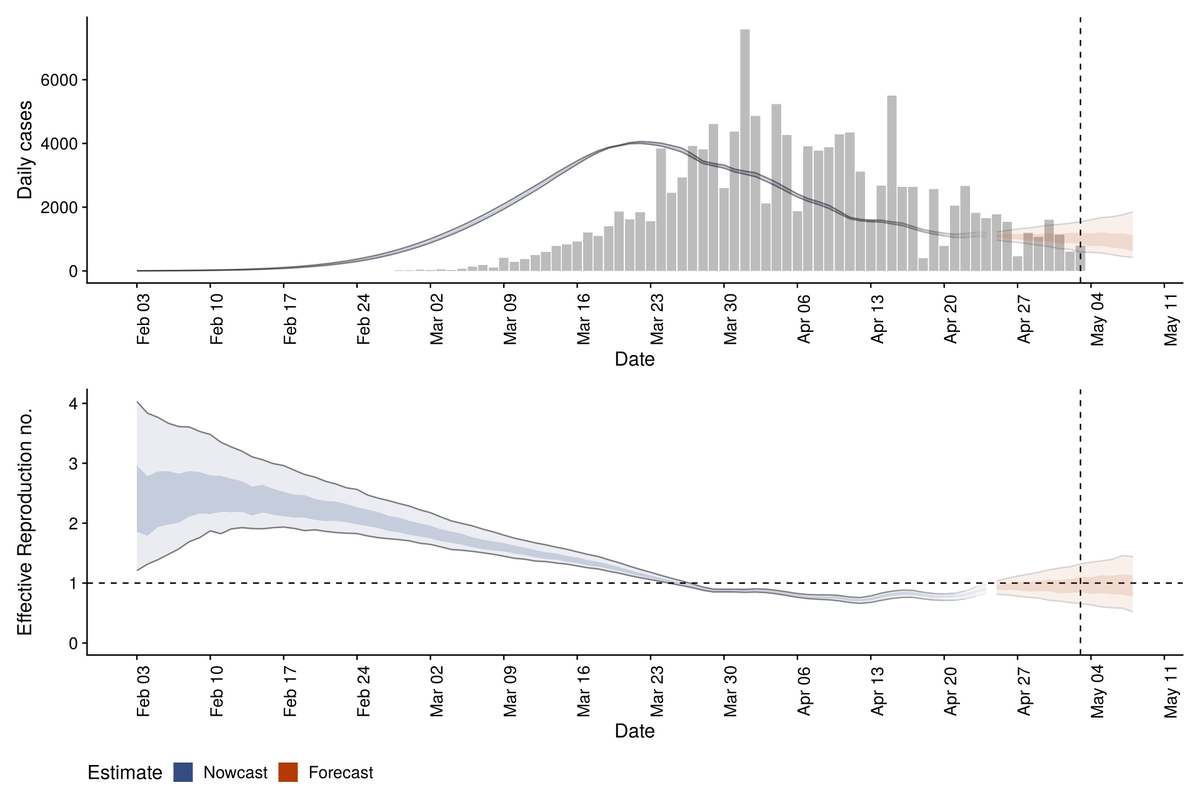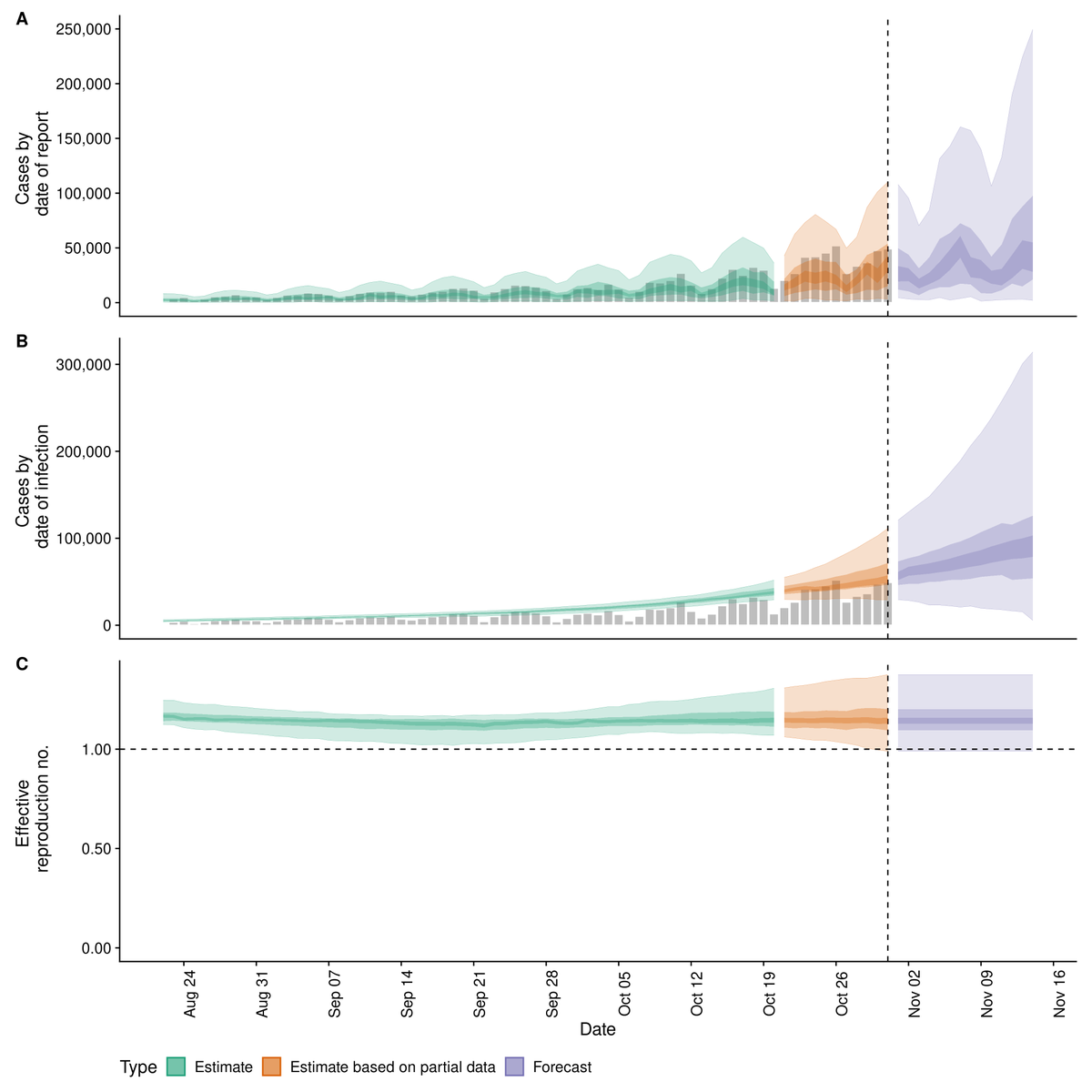
✽ An important clarification which I feel I have to make concerning “herd immunity”, its value and more importantly, its definition. The point is, the basic reproduction number R₀ describes a population that is immunologically AND sociologically “naïve”. •1/32
In other words, R₀ describes (the number of individuals who will be infected, on average, by one infected individual inside) a population which has never come in contact with the virus, but doesn't even know about it, care about it, or take any kind of precaution. •2/32
Consequently, if we apply the formula 1 − 1/R (which itself has many caveats and limitations, but it's not the point I'm trying to make here) to this number R₀, we are computing a herd immunity threshold for a naïve population as described in the previous tweet: … •3/32
… in other words, this — let's call it “unconditional” — herd immunity threshold is the proportion of individuals who must become immune for the disease to no longer spread in a population which takes NO precautions to protect itself, and hasn't even HEARD of the disease. •4/32
For covid, this R₀ was estimated at around 3-ish (or actually anywhere from 2 to 6), back in March, from the initial January–February outbreak in Wǔhàn, in a population which was, indeed, arguably “naïve” at the time. •5/32 nejm.org/doi/10.1056/NE…
But ✳︎SPOILER✳︎: quite a few people around the world have heard about covid-19 by now. 😐 •6/32
Now if we consider a population which already has partial immunity and/or is taking any kind of precautions against the disease (e.g., traveling less, wearing masks, or anything of the sort), we have a different reproduction number R₁<R₀, … •7/32
… and of course the number of people who must be made immune in this non-naïve population in order to stabilize the disease is 1 − 1/R₁ (again with many caveats and limitations), NOT 1 − 1/R₀. We might call this “conditional” herd immunity: … •8/32
… all this means is that it doesn't have to be either pure full unconditional herd immunity or pure interventions which stabilize the disease: it can be any combination of them. (This point should be blindingly obvious, but some people seem to fail to grasp it.) •9/32
“Conditional” herd immunity means that some combination of immunity and other measures stabilize the spread of the disease: it's not a well-defined point, of course, it's a spectrum with unconditional herd immunity at one end and lockdowns at the other. •10/32
Essentially ANY place where the disease is no longer progressing in an exponential factor HAS attained some form of conditional herd immunity, meaning that some combination of collective immunity and other measures are stabilizing it. •11/32
Now if you compute the herd immunity threshold with the 1 − 1/R formula by plugging in R=R₀, which is the case if you think it's around 60% (namely for R₀=2.5) it means you're aiming at stabilizing the disease using ONLY collective immunity, NO further measures. •12/32
(Note only no further measures, but even going as far as assuming your population doesn't know about covid, doesn't care about covid, will take no steps to protect itself against covid, and behave in every way as the “naïve” population for which R₀ was measured.) •13/32
This is very much a straw man argument, then, because I don't think, even with a vaccine, anyone would seriously suggest this “let's just completely ignore covid and forget it even exists” approach, which is the one for which you would need to immunize 1 − 1/R₀ people. •14/32
I therefore call it a straw man to use the 1 − 1/R₀ value (around 60%) for herd immunity threshold except if one made sure the person one is arguing with is indeed defending the “completely ignore covid” approach outlined in the previous tweet. •15/32
In any other case, one must use the formula 1 − 1/R with a value of R that realistically describes the population being considered, in the country or area being considered, with the level of protective measures they are willing to take (especially in the long run). •16/32
Now one of the striking properties of the covid pandemic is how R(t) fell very rapidly even before any kind of measures were imposed “from above” (e.g., lockdowns). E.g., this graph taken from web.archive.org/web/2020050912… (archived version of worldometers.info/coronavirus/co…) … •17/32 

… shows how France's reproduction number evolved with time, and dropped from around R₀=2.5 down to 1.5 before lockdown started on 2020-03-17. Since then it has hovered between roughly 0.75 and 1.5 (it was around 1.2 just before second lockdown). •18/32
In fact, it's been fairly stable as of recently around 1.2: epiforecasts.io/covid/posts/na… (no particularly big jump either up or down as a result of anything). •19/32 

Other sources report more variability in R(t), whose computation is delicate and fraught with uncertainty, see
https://twitter.com/gro_tsen/status/1320327001258008578— but at any rate, it's always in the 1.2-ish range for European countries right now (and I mean, even before second lockdowns). •20/32
In fact I don't remember seeing a country with R>1.5 more than briefly since covid really became a global pandemic, and certainly not recently. (I don't spend my time looking at these graphs so I may have missed some, though. But they're certainly not typical.) •21/32
Now the REASON why R has fallen so rapidly from R₀~2.5 down to values in the 1.0 to 1.5 ballpark range is unclear. It could be due to many things (less mobility, masks, partial immunity, or a host of other things — nothing very satisfactory), but that's not my point. •22/32
My point is that the R₀ value of 2.5 (or even higher!) and the corresponding “unconditional” herd immunity threshold of around 60%, are completely irrelevant except as straw man arguments or if talking to a deranged person who would argue as in tweet 14 above. •23/32
In the real world, the relevant value of R is somewhere around 1.2, perhaps 1.1 to 1.5, depending of course on exactly what measures are deemed acceptable in the long run, giving a “conditional” herd immunity threshold between 10% and 30% maybe. •24/32
(And of course, this is applying the 1 − 1/R formula which still has a lot of caveats which I don't want to get into in this thread, but one expects the actual value to be lower if any kind of heterogeneity is involved, e.g., between urban and rural areas.) •25/32
This is not to say the formula 1 − 1/R₀ is wrong, or that people who refer to it are wrong. But it is to say that it is deeply misleading unless you are advocating (or speaking with someone who is advocating) a “let's completely forget that covid even exists” strategy. •26/32
Essentially this is a false dichotomy argument which consists of assuming that if somebody is arguing against lockdowns then they must be in the “completely forget that covid even exists and do nothing” (straw man) extreme. •27/32
This makes me particularly angry coming from epidemiologists who should know better, e.g., Fontanet and Cauchemez in their now infamous comment “Covid-19 herd immunity: where are we?” nature.com/articles/s4157… — which uses R₀~2.5 WITHOUT SO MUCH AS A COMMENT. •28/32
And sadly, the upper bound of their (already pessimistic for many other reasons) 100k–450k death range for France to attain (unconditional!) herd immunity has been reused by French president Macron to justify the second French lockdown: … •29/32
… thus using the false dichotomy mentioned in tweet 27 above: “if we don't have this lockdown, this means we're pursuing unconditional herd immunity [←false dichotomy], which will cause 400 000 deaths [←upper bound of an already pessimistic interval]”, … •30/32
… as if not having this lockdown automatically entailed giving up on everything that has been done to limit the spread of covid. This is just plain silly. A more reasonable estimate uses 1 − 1/R₁ with R₁~1.2 observed in France since mid-July: •31/32
https://twitter.com/gro_tsen/status/1319403907899150336
Of course, all of this is nothing that I didn't already write in this old thread back in April. But I thought relevant to rewrite it now in a slightly different manner. •32/32
https://twitter.com/gro_tsen/status/1250817310526525440
• • •
Missing some Tweet in this thread? You can try to
force a refresh


